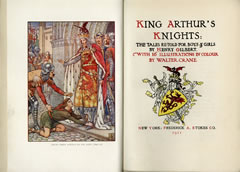King Arthur's Knights: The Tales Re-Told for Boys & Girls
You may click on the thumbnail images to view them full screen

Gilbert, Henry. King Arthur's Knights: The Tales Re-Told for Boys & Girls. With 16 illustrations in colour by Walter Crane. New York: Frederick A. Stokes, 1911.
Walter Crane (1845-1915) provided sixteen color illustrations for Henry Gilbert's King Arthur's Knights: The Tales Re-Told for Boys and Girls, first published in 1911. Those images, republished in 1915 in an abridged edition with only eight of the illustrations as The Knights of the Round Table, were the last of his book illustrations printed before his death in 1915.
In his preface to the 1911 volume, Gilbert had noted that King Arthur's Knights was an 'attempt to tell some of the stories of King Arthur and his Knights in a way which will be interesting to every boy and girl who loves adventures.' But unlike the often 'tedious and dry' Morte D'Arthur 'from your father's bookshelves,' his stories, Gilbert professed, were written, in simple language, to emphasize select episodes from Malory and the Mabinogion about the responsibilities of 'the perfect knight' and the great lessons of chivalry.

Roughly half of his illustrations for the volume focused, directly or indirectly, on King Arthur and Sir Lancelot, the most celebrated of his Round Table companions. Crane portrayed Arthur at some of the most familiar and significant moments in his life, from the drawing of the sword in the stone and the acquisition of Excalibur from the Lady of the Lake (to whom Bedevere returns it in the final illustration of the volume) to the arrival of Galahad at court to assume the Siege Perilous and complete the fabled Round Table. And Crane depicted various episodes featuring Lancelot: in the Chapel Perilous, in the queen's antechamber, where he engages the knights loyal to Mordred (although, in this bowdlerized version, Mordred—who is jealous of Lancelot's fame—accuses him of treachery against Arthur rather than adultery with Gwenevere); and ultimately alone in the chapel, where he lies, rosary in hand, atop the tomb of Arthur, to whom he is at last reconciled. (Lancelot is also invoked—though not pictured—in the image of the tragic Elaine, who dies for love of him and whose body is brought to Camelot for all of Arthur's court to mourn.)

How Arthurian stories and images might serve as models of behavior for the young can be seen in the depiction of the moment in the fight outside Joyous Gard when Lancelot forbids Bors to harm the king. This same incident was selected by William Dyce (1806-1864) when he chose scenes from the Morte d'Arthur to represent virtues in the commission he received to decorate the Queen's Robing Room in the New Palace at Westminster, a project begun in 1848. In one of the frescos that Dyce painted, Generosity is exemplified by King Arthur Unhorsed Spared by Launcelot.
